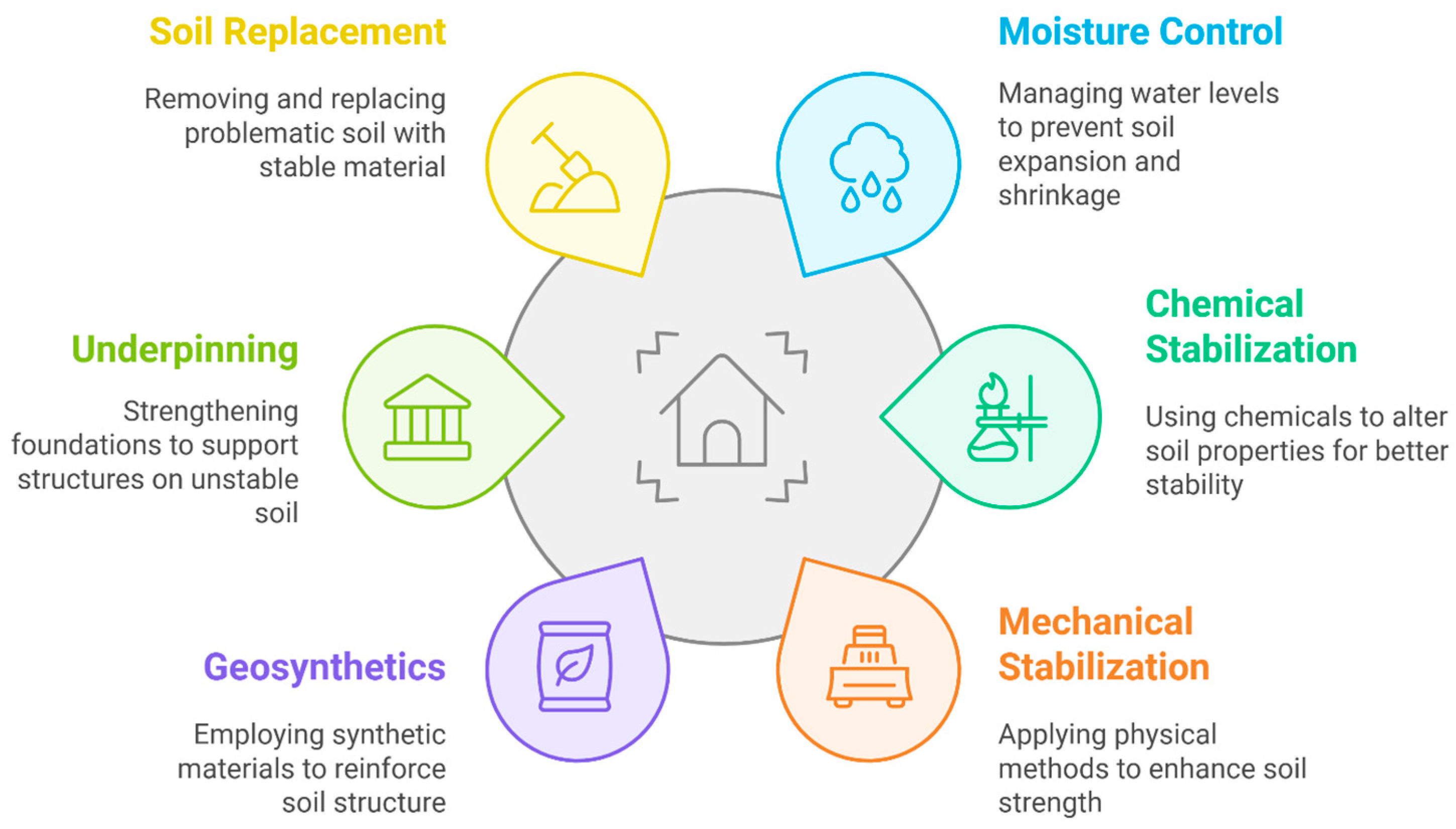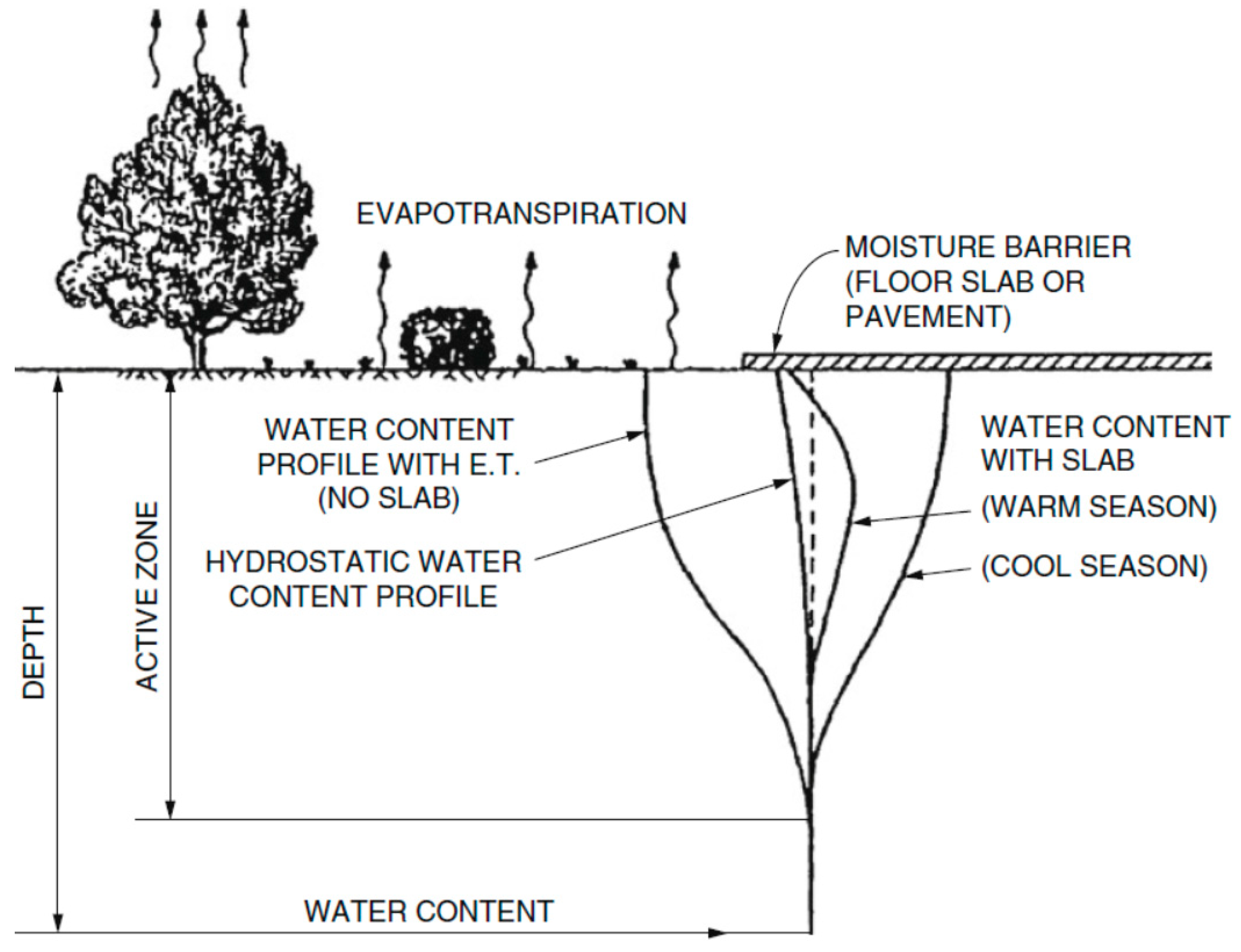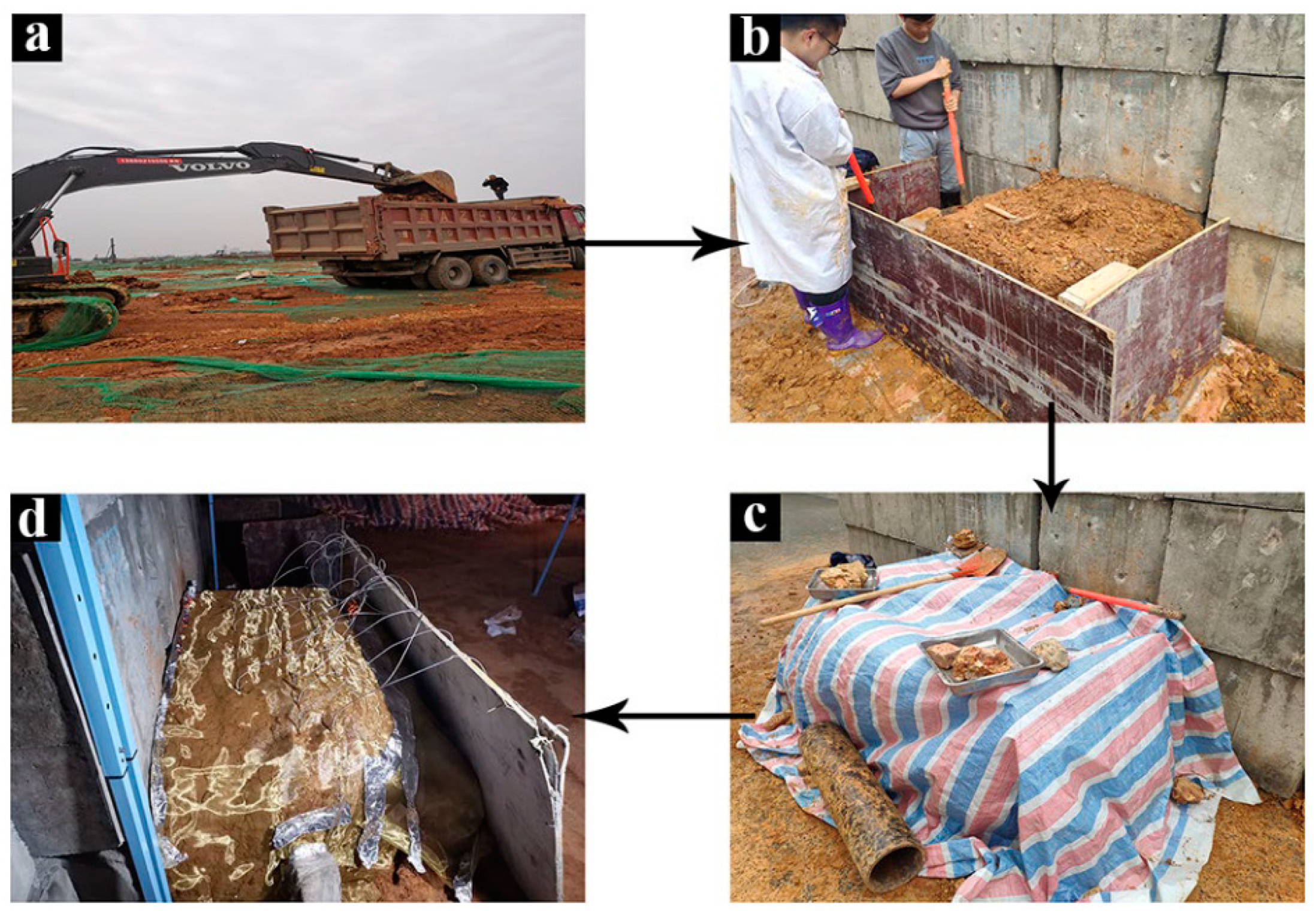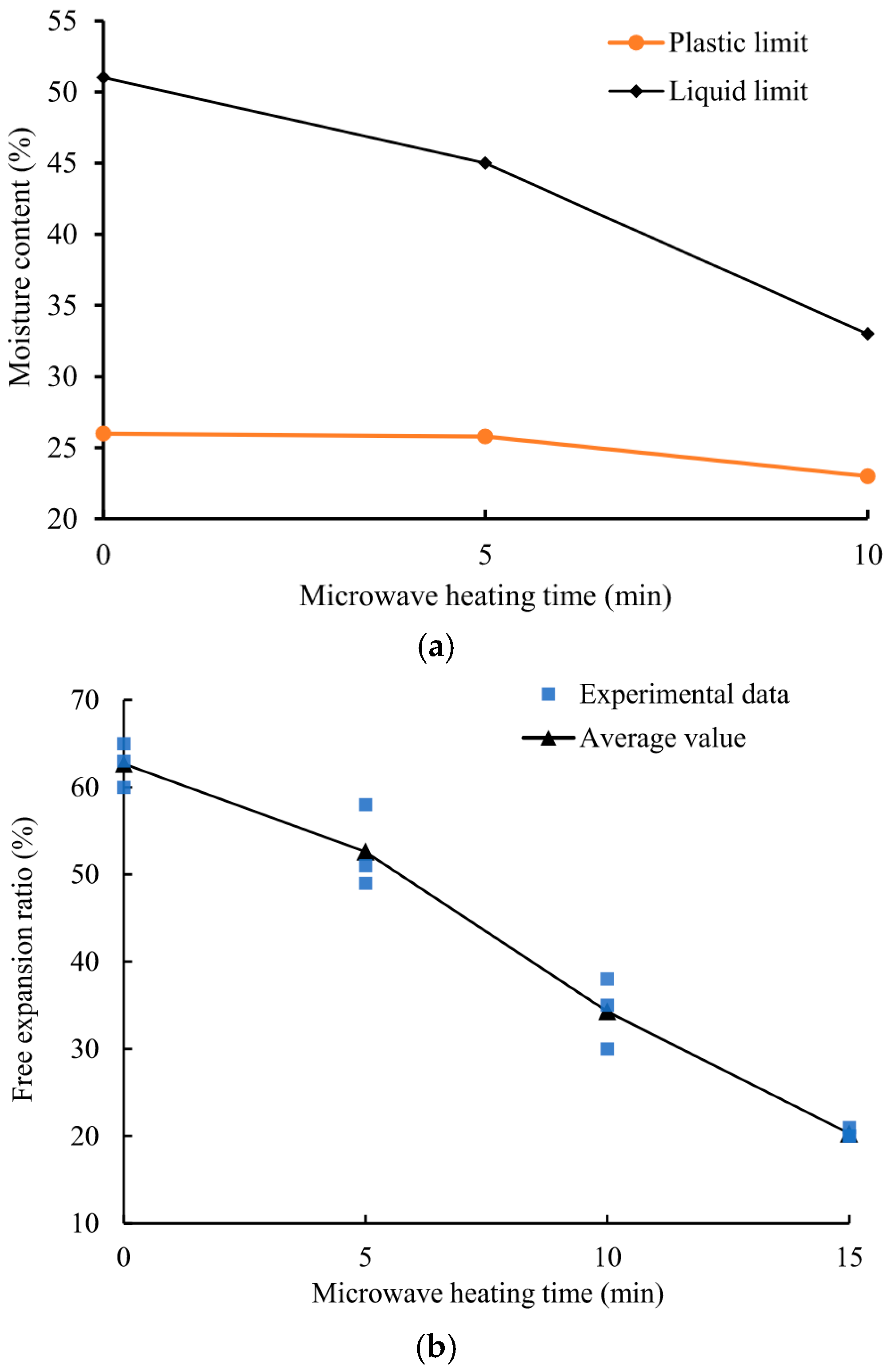Innovative Thermal Stabilization Methods for Expansive Soils: Mechanisms, Applications, and Sustainable Solutions
Abstract
1. Introduction
2. Background on Expansive Soils and Stabilization Methods
3. Mineralogy and Composition
3.1. Clay Minerals Responsible for Expansiveness
3.2. Soil–Water Interactions
4. Factors Affecting Expansiveness
5. Thermal Properties of Expansive Soils
6. Effects of Extreme Heating on Expansive Soil Properties
6.1. Swelling Behavior and Thermal Stabilization
6.2. Changes in Physical and Chemical Properties
6.3. Microwave Heating and Its Implications
6.4. High-Temperature Effects on Soil Strength and Plasticity
6.5. Combined Thermal and Chemical Stabilization
| Reference | Methods Used | Type of Tested Soil | Application Method of Heating | Main Results | |
|---|---|---|---|---|---|
| 1 | Rahil et al. [61] | Laboratory-prepared soils mixed with 20–60% bentonite, heated at 400 °C for 6 h using electric heaters at varying borehole spacings (4.16 d, 6.25 d, and 8.33 d), where “d” represents the diameter of the boreholes. | Expansive soil (Kut area, Iraq), bentonite mix | Electric cartridge heaters in boreholes (13.5 mm diameter), maintained at 400 °C for 6 h, followed by 24 h cooling. |
|
| 2 | Yao et al. [8] |
| Expansive soil (Hefei, China), rich in montmorillonite | Soil heated in a quartz crucible at 4 kW for three durations (5–15 min). Structural water escape and dehydroxylation induced chemical changes. |
|
| 3 | Joshi et al. [63] |
| Kaolinite, bentonite, Western Beaufort Sea clay | Oven-dried samples heated in a muffle furnace at 3 °C/min, held at target temperature for 2 h, cooled overnight. |
|
| 4 | Wang et al. [7] |
| Edgar Plastic Kaolin (EPK) and Western Bentonite (WB) | Electric furnace, incremental heating to avoid shrinkage cracking. Swelling measured post heating. |
|
| 5 | Kabubo et al. [20] |
| Black cotton soil (Mwihoko area, Kenya) | Soil heated in a closed electric kiln, cooled to room temperature to assess reversibility of changes. |
|
| 6 | Li et al. [57] |
| Expansive soil (Hanzhong, Shanxi Province, China) | Controlled heating via Netzsch analyzer under dry nitrogen atmosphere. TG/DTA analyzed water loss and microstructural changes. |
|
| 7 | Al-Swaidani et al. [62] |
| Expansive clayey soil (Syria, 3 sites) | Clay heated for 3 h at different temperatures, and then blended with untreated soil (0%, 10%, 20% replacement). |
|
| 8 | Zhang et al. [58] (preprint) |
| Expansive soil | Microwave irradiation at various temperatures (200–500 °C) |
|
| 9 | Hu et al. [59] |
| Wasted clayey soil | In situ microwave irradiation (2.45 GHz, 1.25 kW). |
|
7. Technical and Practical Implementation Challenges
7.1. Energy Intensity and Cost
7.2. Environmental Concerns
7.3. Variability in Soil Behavior
7.4. Limitations in Practical Implementation
7.5. Long-Term Performance and Uncertainty
7.6. Infrastructure and Heating Patterns
7.7. Economic and Social Considerations
8. Extreme Heating Techniques for Soil Stabilization
9. Conclusions
- Efficacy of Thermal Treatment:
- Thermal treatment, whether through conventional heating or innovative methods like microwave irradiation, induces profound and often irreversible changes in expansive soils.
- These changes include the transformation of clay mineral structures (e.g., conversion of smectites), alterations in soil fabric, and improvements in key engineering properties like compressive strength and swelling potential.
- Challenges and Limitations:
- Energy Intensity and Cost: Many thermal methods, especially those relying on traditional fuel combustion, are energy-intensive, raising economic and environmental concerns. Scalability and cost-effectiveness of microwave heating remain under investigation.
- Soil Heterogeneity: The inherent variability in natural soil deposits complicates the standardization of treatment protocols and necessitates site-specific adjustments.
- Depth of Penetration: Achieving uniform treatment at depth, particularly with microwave heating, remains a challenge due to energy attenuation.
- Long-Term Performance: The long-term durability of thermally treated soils under various environmental conditions requires further research and field validation.
- Future Research Directions:
- Optimization of Energy Efficiency: Exploring more energy-efficient heating methods and optimizing existing techniques are crucial for practical viability.
- Refinement of Application Techniques: Developing robust field implementation strategies that address soil heterogeneity and ensure uniform treatment.
- Comprehensive Field Validation: Conducting long-term field trials and monitoring programs to assess the durability and performance of treated soils under real-world conditions.
- Life-Cycle Assessments: Evaluating the environmental and economic impacts of thermal stabilization across the entire project lifecycle.
- Multidisciplinary Approach:
- Successfully transitioning thermal stabilization from a promising concept to widespread practice will require collaborative efforts, integrating insights from geotechnical engineering, materials science, and environmental engineering.
Author Contributions
Funding
Conflicts of Interest
References
- Jones, L. Expansive Soils. In Encyclopedia of Engineering Geology; Bobrowsky, P., Marker, B., Eds.; Springer International Publishing: Cham, Switzerland, 2017; pp. 1–7. [Google Scholar] [CrossRef]
- Devkota, B.; Karim, M.R.; Rahman, M.M.; Nguyen, H.B.K. Accounting for Expansive Soil Movement in Geotechnical Design—A State-of-the-Art Review. Sustainability 2022, 14, 15662. [Google Scholar] [CrossRef]
- Bouassida, M.; Manigniavy, S.A.; Tani, N.K.; Bouassida, Y. Expansive Soils: Is It a Hidden Problem in Civil Engineering? In Advances in Research in Geosciences, Geotechnical Engineering, and Environmental Science; Baba, K., Ouadif, L., Nounah, A., Bouassida, M., Eds.; Springer Nature: Cham, Switzerland, 2023; pp. 424–431. [Google Scholar]
- Hamid, W.; Lemboye, K.; Dhowian, A. Characteristics and treatment of expansive soil using biopolymer. Arab. J. Geosci. 2022, 15, 411. [Google Scholar] [CrossRef]
- Mitchell, J.K. Temperature Effects on the Engineering Properties and Behavior of Soils. 1969. Available online: https://onlinepubs.trb.org/Onlinepubs/sr/sr103/103-002.pdf (accessed on 15 November 2024).
- Selvakumar, S.; Soundara, B.; Raj, N.; Kulanthaivel, P. Microstructural investigation on the expansive soils for sustainable stabilization purposes. Discov. Soil 2024, 1, 8. [Google Scholar] [CrossRef]
- Wang, M.C.; Jao, M.; Ghazal, M.S. Heating effect on swelling behaviour of expansive soils. Geomech. Geoengin. 2008, 3, 121–127. [Google Scholar] [CrossRef]
- Yao, H.; Lu, J.; Bian, H.; Zhang, Z. Influence of microwave heating on the swelling properties of expansive soil in Hefei. Case Stud. Therm. Eng. 2022, 39, 102466. [Google Scholar] [CrossRef]
- Huang, Z.; Shi, H.; Zhang, W.; Ma, S.; Gao, F.; Ma, M. Expansive Soil Embankment Filling and Cutting Treatment Technology: A Systematic Review. Adv. Mater. Sci. Eng. 2022, 2022, 4045620. [Google Scholar] [CrossRef]
- Stãnciucu, M.; Dogaru, I. Geotechnical Hazards Induced by Montmorillonite Presence; IntechOpen: London, UK, 2024. [Google Scholar]
- Wei, J.; Wei, J.; Huang, Q.; Zainal Abidin, S.M.I.B.S.; Zou, Z. Mechanism and Engineering Characteristics of Expansive Soil Reinforced by Industrial Solid Waste: A Review. Buildings 2023, 13, 1001. [Google Scholar] [CrossRef]
- Al-Atroush, M.E.; Shabbir, O.; Almeshari, B.; Waly, M.; Sebaey, T.A. A Novel Application of the Hydrophobic Polyurethane Foam: Expansive Soil Stabilization. Polymers 2021, 13, 1335. [Google Scholar] [CrossRef]
- Hussein, M. Effect of Sand and Sand-Lime Piles on the Behavior of Expansive Clay Soil. Adv. Civ. Eng. 2021, 2021, 4927078. [Google Scholar] [CrossRef]
- Alnmr, A.; Ray, R.P. Review of the effect of sand on the behavior of expansive clayey soils. Acta Tech. Jaurinensis 2021, 14, 521–552. [Google Scholar] [CrossRef]
- Wiratama, R.A.; Hanudin, E.; Purwanto, B.H. Intercalation and calcination as methods to reduce expansive soil properties. Sains Tanah-J. Soil Sci. Agroclimatol. 2021, 18, 36–47. [Google Scholar] [CrossRef]
- Jalal, F.E.; Xu, Y.; Jamhiri, B.; Memon, S.A. On the Recent Trends in Expansive Soil Stabilization Using Calcium-Based Stabilizer Materials (CSMs): A Comprehensive Review. Adv. Mater. Sci. Eng. 2020, 2020, 1510969. [Google Scholar] [CrossRef]
- Kabubo, C.K.; Gariy, Z.A.; Mwea, S.K.; Abuodha, S.O. The Effect of Varying Heat Temperatures on the Grading and the Swelling Behaviour of Expansive Clay Soils. Int. J. Sci. Res. IJSR 2015, 6, 2371–2377. [Google Scholar] [CrossRef]
- Petry, T.; Little, D. Review of Stabilization of Clays and Expansive Soils in Pavements and Lightly Loaded Structures—History, Practice, and Future. J. Mater. Civ. Eng. 2002, 14, 447–460. [Google Scholar] [CrossRef]
- Agurto, M.; Velásquez, E.L.Z.; Navarro, F. Structural changes in clays subjected to heat treatment: An analysis by structural refinement using the Rietveld method. Rev. Mex. Fis. 2021, 67, 061602. [Google Scholar] [CrossRef]
- Kabubo, C.K.; Mwea, S.K.; Abuodha, S.O.; Gariy, Z.A. The Effect of Heat on the Properties of Expansive Clay Soil. Int. J. Sci. Res. IJSR 2017, 6, 464–469. [Google Scholar] [CrossRef]
- Guimarães, L.; Gens, A.; Olivella, S. Coupled Thermo-Hydro-Mechanical and Chemical Analysis of Expansive Clay Subjected to Heating and Hydration. Transp. Porous Media 2007, 66, 341–372. [Google Scholar] [CrossRef]
- Thomas, H.; Cleall, P. Inclusion of expansive clay behaviour in coupled thermo hydraulic mechanical models. Eng. Geol. 1999, 54, 93–108. [Google Scholar] [CrossRef]
- Delage, P.; Sultan, N.; Cui, Y.-J. On the thermal consolidation of Boom clay. Can. Geotech. J. 2000, 37, 343–354. [Google Scholar] [CrossRef]
- Aitken, M.; Tite, M.; Reid, J. Thermoluminescent Dating of Ancient Ceramics. Nature 1964, 202, 1032–1033. [Google Scholar] [CrossRef]
- Kostadinova-Avramova, M.; Kovacheva, M. The magnetic properties of baked clays and their implications for past geomagnetic field intensity determinations. Geophys. J. Int. 2013, 195, 1534–1550. [Google Scholar] [CrossRef]
- Del Pino Curbelo, M.; Day, P.; Díaz, J.S.; Atiénzar, G.G.; De Togores Muñoz, C.R. Cutting down on the grog: The crystallisation of Neolithic ceramic traditions at Cova d’En Pardo (Alicante, Spain) and cultural change in the western Mediterranean basin (mid-6th and 5th millennia cal. BC). Archaeol. Anthropol. Sci. 2021, 13, 11. [Google Scholar] [CrossRef]
- Tema, E.; Ferrara, E. Magnetic measurements as indicator of the equivalent firing temperature of ancient baked clays: New results, limits and cautions. J. Cult. Herit. 2019, 35, 64–75. [Google Scholar] [CrossRef]
- Goutham, D.; Krishnaiah, A. Improvement in Geotechnical Properties of Expansive Soil Using Various Stabilizers: A Review. Int. J. Eng. Manuf. 2020, 10, 18. [Google Scholar] [CrossRef]
- Kanagarathinam, L.; Anburaja, D.; Sudharson, G.; Keerthana, P.; Karpoorajothi, S. Soil Stabilization Techniques for Roads on Expansive Soils and Loose Sand. In Proceedings of the IOP Conference Series: Materials Science and Engineering, Sanya, China, 12–14 November 2021; IOP Publishing: Bristol, UK, 2021; Volume 1026, p. 012013. [Google Scholar] [CrossRef]
- Osman, K.T. Expansive Soils. In Management of Soil Problems; Osman, K.T., Ed.; Springer International Publishing: Cham, Switzerland, 2018; pp. 117–143. [Google Scholar] [CrossRef]
- Abbey, S.J.; Eyo, E.U.; Ng’ambi, S. Swell and microstructural characteristics of high-plasticity clay blended with cement. Bull. Eng. Geol. Environ. 2020, 79, 2119–2130. [Google Scholar] [CrossRef]
- Lu, N. Linking Soil Water Adsorption to Geotechnical Engineering Properties. In Geotechnical Fundamentals for Addressing New World Challenges; Lu, N., Mitchell, J.K., Eds.; Springer International Publishing: Cham, Switzerland, 2019; pp. 93–139. [Google Scholar] [CrossRef]
- AL-Bazali, T. A critical investigation of diffuse double layer changes in clay-electrolyte systems at high temperatures. J. Geophys. Eng. 2022, 19, 940–954. [Google Scholar] [CrossRef]
- Du, J. Swelling Mechanism and Swelling Behaviour of Expansive Clay and Clay Minerals. Ph.D. Thesis, RMIT University, Melbourne, Australia, 2023. [Google Scholar] [CrossRef]
- Hussein, M.M.A. Effect of different water types on expansive soil behavior. Life Sci. J. 2016, 13, 89–94. [Google Scholar]
- Zamin, B.; Nasir, H.; Sikandar, M.A.; Ahmad, W.; Khan, B.J.; Ahmad, M.; Bashir, M.T. Comparative Study on the Field- and Lab-Based Soil-Water Characteristic Curves for Expansive Soils. Adv. Civ. Eng. 2022, 2022, 6390442. [Google Scholar] [CrossRef]
- Tan, X.; Shen, M.; Hu, N.; Yu, W. Soil-water characteristics of expansive soil considering volume change. J. Guangxi Univ. Nat. Sci. Ed. 2013, 38, 884–891. [Google Scholar]
- Dasog, G.S.; Mermut, A.R. Expansive Soils and Clays. In Encyclopedia of Natural Hazards; Bobrowsky, P.T., Ed.; Encyclopedia of Earth Sciences Series; Springer: Dordrecht, The Netherlands, 2013; pp. 297–300. [Google Scholar] [CrossRef]
- Khademi, F.; Budiman, J. Expansive soil: Causes and treatments. Manag. J. Civ. Eng. 2016, 6, 1. [Google Scholar] [CrossRef]
- A Elarabi, H. Factors Influencing swelling Behaviour of Expansive Soils. 2004. Available online: https://www.researchgate.net/publication/270787736_Factors_Influencing_Swelling_Behaviour_of_Expansive_Soil (accessed on 1 February 2025).
- Mehta, B.; Sachan, A. Effect of mineralogical properties of expansive soil on its mechanical behavior. Geotech. Geol. Eng. 2017, 35, 2923–2934. [Google Scholar]
- Hajjat, J.; Al-Jeznawi, D.; Sánchez, M.; Avila, G. Effects of drying and soil-base interface on the behavior of an expansive soil mixture. Geotech. Geol. Eng. 2020, 38, 4637–4649. [Google Scholar]
- Mathewson, C.C. Expansive soils, engineering geology. In General Geology; Springer: Boston, MA, USA, 1988; pp. 114–119. [Google Scholar] [CrossRef]
- Nelson, J.; Miller, D.J. Expansive soils: Problems and Practice in Foundation and Pavement Engineering; John Wiley & Sons: Hoboken, NJ, USA, 1997. [Google Scholar]
- Glenn, E.W. Study of the Foundation Soils at College Station, Texas. Ph.D. Thesis, A. & M. College of Texas, College Station, TX, USA, 1931. [Google Scholar]
- Abu-Hamdeh, N.H. Thermal Properties of Soils as affected by Density and Water Content. Biosyst. Eng. 2003, 86, 97–102. [Google Scholar] [CrossRef]
- Kersten, M.S. Thermal Properties of Soils. 1949. Available online: https://conservancy.umn.edu/items/52fe807f-42d8-4d55-b644-0e3de3f54377 (accessed on 23 November 2024).
- Derkowski, A.; Kuligiewicz, A. Thermal Analysis and Thermal Reactions of Smectites: A Review of Methodology, Mechanisms, and Kinetics. Clays Clay Miner. 2022, 70, 946–972. [Google Scholar] [CrossRef]
- Johnson, R.; Tratnyek, P.; Johnson, R.O. Persulfate persistence under thermal activation conditions. Environ. Sci. Technol. 2008, 42, 9350–9356. [Google Scholar] [CrossRef] [PubMed]
- Zhao, C.; Dong, Y.; Feng, Y.; Li, Y.; Dong, Y. Thermal desorption for remediation of contaminated soil: A review. Chemosphere 2019, 221, 841–855. [Google Scholar] [CrossRef]
- Kramarenko, V.V.; Nikitenkov, A.N.; Yu Molokov, V.; Shramok, A.V.; Pozdeeva, G.P. Application of microwave method for moisture determination of organic and organic-mineral soils. IOP Conf. Ser. Earth Environ. Sci. 2016, 33, 012040. [Google Scholar] [CrossRef]
- Youcef, F.; Kairouani, D.; Boukarkar, F.; Aïssa, B.H. Comparison between two gypsum content determination methods applied to the study of soils in arid regions. J. Agric. Appl. Biol. 2023, 4, 182–190. [Google Scholar] [CrossRef]
- Wang, L.; Roy, A.; Tittsworth, R.; Seals, R. Mineralogy of Soil Susceptible to Sulfate Attack after Stabilization. J. Mater. Civ. Eng. 2004, 16, 375–382. [Google Scholar] [CrossRef]
- Wan, X.; Zhong, C.; Mohamed, H.; Qiu, E.; Qu, M.; Nkiegaing, F. Study on the thermal conductivity model of sodium sulfate soils. Exp. Heat Transf. 2020, 34, 217–239. [Google Scholar] [CrossRef]
- Plante, A.; Fernández, J.; Leifeld, J. Application of thermal analysis techniques in soil science. Geoderma 2009, 153, 1–10. [Google Scholar] [CrossRef]
- Cho, K.; Kang, J.; Kim, S.-B.; Purev, O.; Myung, E.-J.; Kim, H.; Choi, N. Effect of inorganic carbonate and organic matter in thermal treatment of mercury-contaminated soil. Environ. Sci. Pollut. Res. Int. 2021, 28, 48184–48193. [Google Scholar] [CrossRef] [PubMed]
- Li, J.; Wu, X.; Hou, L. Physical, Mineralogical, and Micromorphological Properities of Expansive Soil Treated at Different Temperature. J. Nanomater. 2014, 2014, 848740. [Google Scholar] [CrossRef]
- Zhang, R.; Hu, Q.; Gu, Y.; He, L.-P. Study on the effect of microwave irradiation improvement on the long-term stability of expansive soil. Res. Sq. 2024. [Google Scholar] [CrossRef]
- Hu, Q.; Liu, Z.; He, L.; Gu, Y.; Zeng, J.; Li, M. Study on microwave heating in-situ treatment of wasted clayey soil. J. Soils Sediments 2023, 23, 3345–3361. [Google Scholar] [CrossRef]
- Abu-Zreig, M.M.; Al-Akhras, N.M.; Attom, M.F. Influence of heat treatment on the behavior of clayey soils. Appl. Clay Sci. 2001, 20, 129–135. [Google Scholar] [CrossRef]
- Rahil, F.; Baqir, H.; Tumma, N. Effect of Heating Borehole Spacing on Plasticity of Expansive Soil. Eng. Technol. J. 2020, 38, 1062–1068. [Google Scholar] [CrossRef]
- Al-Swaidani, A.M.; Hamood, I.; Meziab, A. Thermally Treated Clay as a Stabilizing Agent for Expansive Clayey Soil: Some Engineering Properties. Stud. Geotech. Mech. 2018, 40, 220–232. [Google Scholar] [CrossRef]
- Joshi, R.C.; Achari, G.; Horsfield, D.; Nagaraj, T.S. Effect of Heat Treatment on Strength of Clays. J. Geoteehnical Eng. 1994, 120, 1080–1088. [Google Scholar]
- Beles, A.A.; Stănculescu, I.I. Thermal Treatment as a Means of Improving the Stability of Earth Masses. Géotechnique 1958, 8, 158–165. [Google Scholar] [CrossRef]
- Litvinov, I. Stabilization of settling and weak clayey soils by thermal treatment. Highw. Res. Board Spec. Rep. 1960, 94–112. [Google Scholar]
- Park, M.-C.; Im, E.-S.; Shin, B.-C.; Han, H.-S. Improvement of shallow soil using electric heating equipment. J. Korean Geotech. Soc. 2012, 28, 41–54. [Google Scholar]
- Bondarenko, O.; Boshkova, I. Evaluation of the efficiency of microwave heating of soils. Technol. Audit. Prod. Reserves 2023, 4, 40–47. [Google Scholar] [CrossRef]





Disclaimer/Publisher’s Note: The statements, opinions and data contained in all publications are solely those of the individual author(s) and contributor(s) and not of MDPI and/or the editor(s). MDPI and/or the editor(s) disclaim responsibility for any injury to people or property resulting from any ideas, methods, instructions or products referred to in the content. |
© 2025 by the authors. Licensee MDPI, Basel, Switzerland. This article is an open access article distributed under the terms and conditions of the Creative Commons Attribution (CC BY) license (https://creativecommons.org/licenses/by/4.0/).
Share and Cite
Alsabhan, A.H.; Hamid, W. Innovative Thermal Stabilization Methods for Expansive Soils: Mechanisms, Applications, and Sustainable Solutions. Processes 2025, 13, 775. https://doi.org/10.3390/pr13030775
Alsabhan AH, Hamid W. Innovative Thermal Stabilization Methods for Expansive Soils: Mechanisms, Applications, and Sustainable Solutions. Processes. 2025; 13(3):775. https://doi.org/10.3390/pr13030775
Chicago/Turabian StyleAlsabhan, Abdullah H., and Wagdi Hamid. 2025. "Innovative Thermal Stabilization Methods for Expansive Soils: Mechanisms, Applications, and Sustainable Solutions" Processes 13, no. 3: 775. https://doi.org/10.3390/pr13030775
APA StyleAlsabhan, A. H., & Hamid, W. (2025). Innovative Thermal Stabilization Methods for Expansive Soils: Mechanisms, Applications, and Sustainable Solutions. Processes, 13(3), 775. https://doi.org/10.3390/pr13030775








